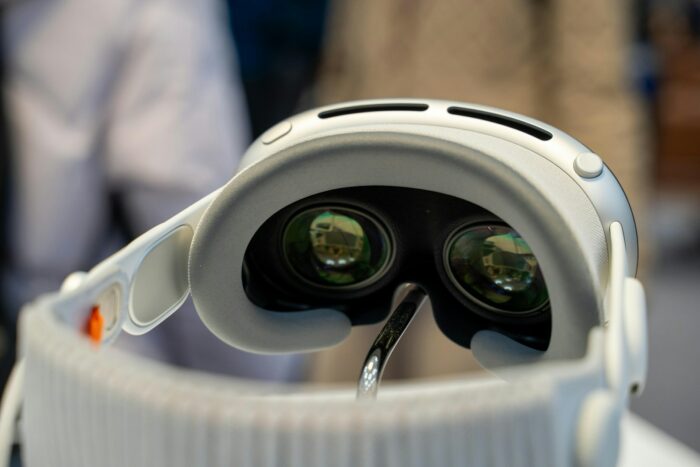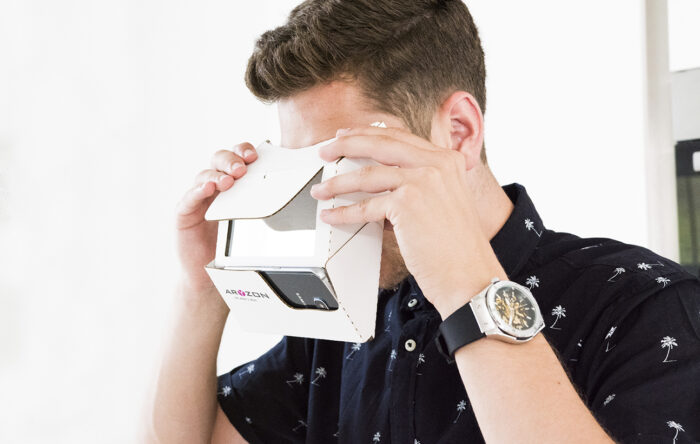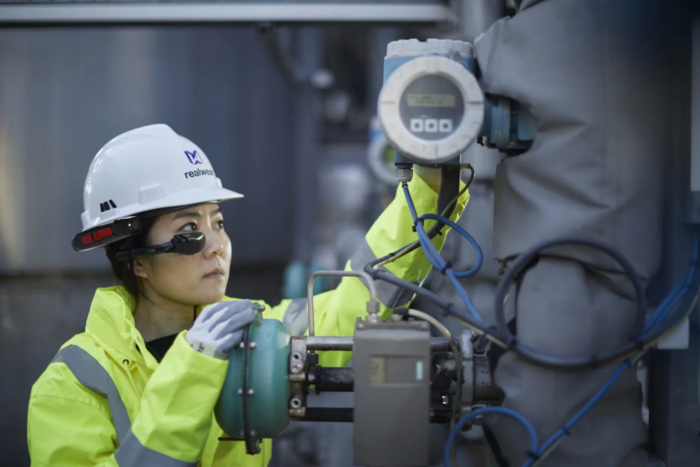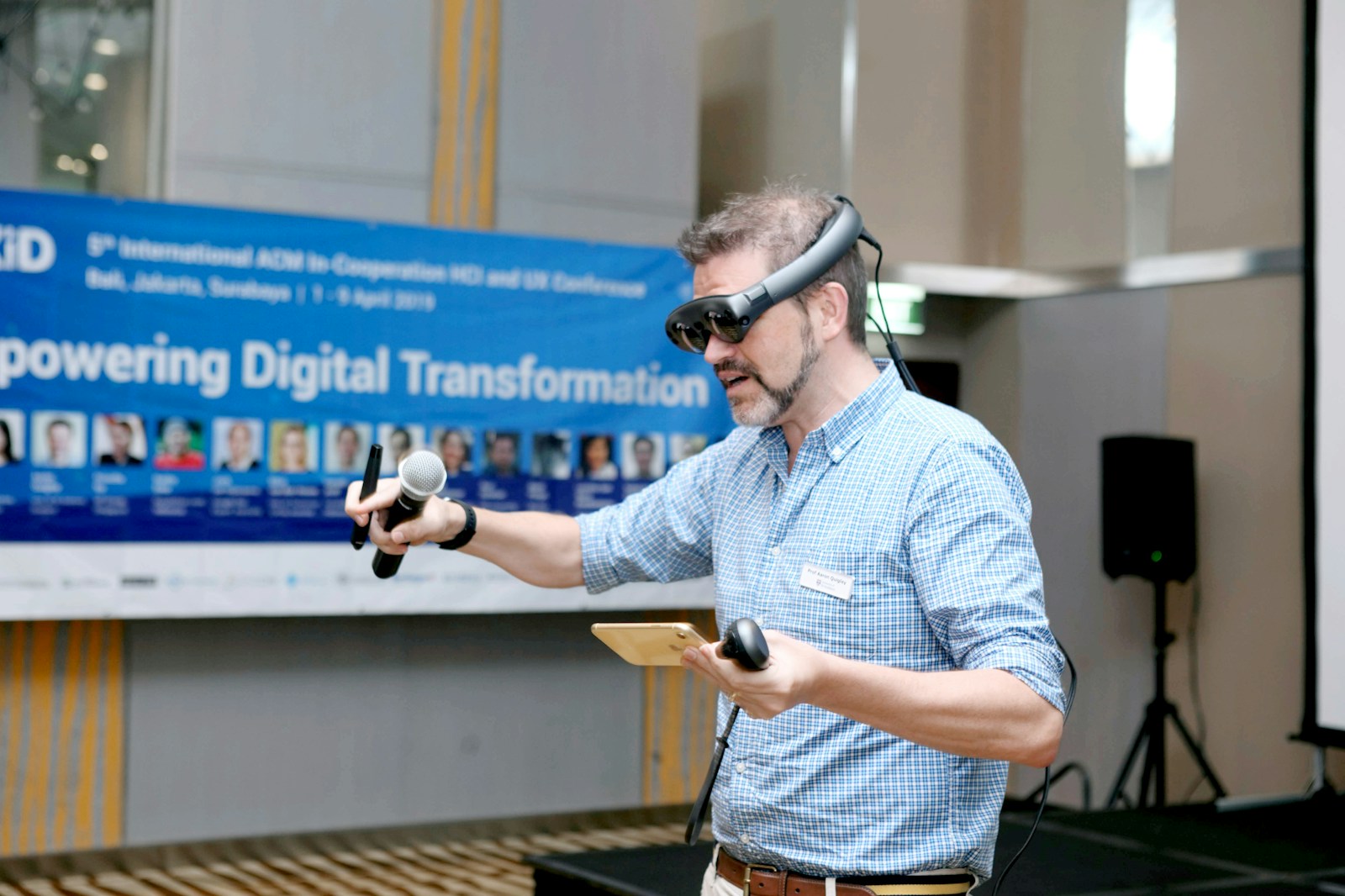The blend of virtual and augmented reality in mixed reality has taken the world by storm with the introduction of the Apple Vision Pro earlier this year and the popularity of Meta Quest with its Quest line of headsets that have met consumer demand for more immersive reality experiences.
This article will illuminate the leading mixed-reality companies pushing the immersive technologies industry forward and the noteworthy projects these companies undertake. The article will also explore what the future of mixed reality looks like.
15 Mixed Reality Companies
1. Apple
Apple, a recent entrant into the mixed reality market, made a significant impact with the release of the Apple Vision Pro in January. With its next-generation FOV, immersive capabilities, and enterprise-driven use cases, this groundbreaking headset met the expectations and hype. It changed public perception of what an immersive reality headset can do and showed the technology industry that mixed reality is here to stay and not just a fad.

Despite its high price point of $3500, the Apple Vision Pro met consumer demand with impressive sales numbers. The Vision Pro demonstrated the market’s readiness for mixed reality products and showcased its potential to go mainstream and change how we perceive immersive reality.
Visit company’s profile page.

2. Meta
Meta is another company that has single-handedly shaped the mixed reality domain with its Quest line of headsets. Coining the word ‘Metaverse,’ Meta looked to change the industry’s paradigm through Meta’s range of mixed reality headsets, creating virtual worlds for its Metaverse.
Meta has had success with its mixed reality headsets in terms of sales. With its latest headset, the Meta Quest 3, an estimated 590,000 units were sold over three months after its release. The Meta Quest 3 has been touted as the best headset released by Meta, with a robust application library and excellent features. Through its quest products, Meta has shaped the industry and will do so for years to come.
Visit company’s profile page.
3. Pico
Pico, headquartered in China and a subsidiary of Bytedance, is a leading virtual reality (VR) and mixed reality (MR) headsets provider. It boasts one of the largest ranges globally and is often considered Meta’s primary competitor in the VR market.
With its latest offerings, such as the Pico 4 and enterprise editions, Pico continues to push boundaries in innovation. While praised for its competitive pricing and quality, Pico headsets, like others in the industry, face usability challenges due to its app store’s limited applications and experiences. Beyond VR, Pico ventures into mixed reality, offering immersive experiences bridging the digital and physical realms.
Visit company’s profile page.

4. Varjo
Varjo, a Finnish company specializing in mixed-reality headsets, has garnered significant funding exceeding $169 million from investors like the Nordic Secondary Fund. The company focuses on crafting groundbreaking headsets tailored for specific industries such as manufacturing, catering to professionals like astronauts and pilots. Their latest release, the Varjo XR-4 series, stands out for its exceptional field-of-view capabilities and immersive experiences, particularly suited for enterprise applications. In summary, Varjo is a leader in virtual reality technology, particularly renowned for its expertise in serving niche industries with advanced headset solutions.
Visit company’s profile page.
5. Ajna Lens
Based in Thane, India, Ajna Lens is a renowned provider of virtual reality solutions. The company specializes in utilizing VR and mixed reality to elevate skill development initiatives across the APAC region, particularly in education. Regarded as a pioneer in VR-led education in India, Ajna Lens leads the forefront of innovation in this sector. Their latest product, the AjnaXR Enterprise Edition VR headset, features state-of-the-art components such as the latest Snapdragon processor and advanced pancake lenses, reflecting the company’s commitment to technological excellence.
Visit company’s profile page.

6. Ximmerse
Ximmerse is a leading AR glasses provider designed to watch cinema-like experiences and gaming. Ximmerse utilizes both AR and VR technologies in mixed reality to create next-generation immersive experiences safely and comfortably with ergonomic features such as adjustable head straps and ergonomic design. Ximmerse is leading the mixed reality field with its innovative headsets, although it has yet to be widely known by the mainstream public.
Visit company’s profile page.
7. Immersed
Immersed is a leading mixed-reality company that aims to remove barriers to workplace efficiency by developing technologies that enable effective remote working to ensure increased productivity. The company will release the world’s smallest 4k headset in mid-2024, called the ‘Visor.’ The device offers ultra 4K screens, all in a compact format, offering the ultimate entertainment and work experience without needing a monitor.
Credit: Immersed
8. Aryzon
Aryzon is a mixed-reality company that offers immersive experiences through its Aryzon headset. The company uses stereoscopic AR to provide functionality to smartphones. Aryzon is headquartered in Enschede, Netherlands, and is a leading provider of mixed reality in the EMEA. Aryzon claims its headsets are the most portable way to experience mixed reality due to affordability compared to other headsets on the market. At the moment, Aryzon offers open-source tools for accessible developer creation.
Visit company’s profile page.

9. Lynx
Lynx is a leading European mixed-reality provider that has yet to release its headset known as the Lynx R1. The Lynx R1, available in both an enterprise edition and development kit, Lynx R1 prioritizes privacy over everything else compared to other headsets on the market, ensuring your data is not used for various purposes. The headset offers true mixed reality, blending AR and VR and touting an ‘open platform’ that lets you completely control your workflows.
Visit company’s profile page.

10. NuEyes
Founded in 2016, NuEyes is a mixed-reality company that blends VR and AR for healthcare. NuEyes Pro 3e, a premium headset by the company, offers users a lightweight design, immersive stereo, and high-definition. NuEyes is leading the way for mixed reality in healthcare, allowing professionals to utilize it in their workflows.

11. RealWear
Realwear utilizes mixed reality and assisted reality for industrial use cases. Assisting front-line workers in dealing with complex and potentially dangerous scenarios, Realwear offers voice-controlled options, access to information, and state-of-the-art features for mixed reality across the Realwear line of headsets. Realwear has around $40 million in funding from the Foundry Group.
Visit company’s profile page.

12. HTC Vive
HTC, a leading phone manufacturer, is also at the forefront of mixed-reality development with a range of headsets released, such as the VIVE XR Elite that offers elite mixed reality focused on enterprise use cases that provide full-color pass-through and depth sensors perfect for training and collaboration. The headset also features 6-Dof tracking as well as a 90Hz refresh rate. The VIVE XR Elite is just one of the premium mixed-reality headsets released by HTC Vive, making it one of the leading mixed-reality companies.
Visit company’s profile page.

13. Microsoft
Microsoft is another provider of mixed reality for enterprises. The Microsoft HoloLens 2 is at the forefront, offering ergonomic enterprise-driven experiences to boost an organization’s productivity. Utilizing HoloLens, companies have seen a 90% increase in efficiency, a 40% reduction in travel, and a 14% decrease in construction costs in engineering. Similarly, healthcare organizations and professionals have seen impressive results when using the HoloLens 2, such as a 305 decrease in ward time. All in all, Microsoft deserves to be on this list.
Visit company’s profile page.

14. Virtue
Virtue has released its own mixed reality headset, coined by the Virtue One XR smart glasses with a 120-inch display. The headset is the go-to device for mixed-reality gaming. Similarly, the device is lightweight and portable, meaning you can play games on the go utilizing mixed reality at its very best.
Visit company’s profile page.
15. Sony
Sony is well known for its PlayStation brand and virtual reality headsets, such as the PlayStation VR 2. Now, Sony is entering the mixed reality market, partnering with Siemens to develop an industrial-grade mixed reality headset for spatial content creation. The headset boasts impressive specifications, such as 4K resolutions and the Snapdragon XR2 Plus Gen 2 chip. Thus, Sony is entering the mixed-reality headset market and is becoming a worthy competitor, especially in the industrial market.
Visit company’s profile page.

Noteworthy Mixed Reality Projects
Across mixed reality, multiple healthcare advancements have been using immersive technology, such as within healthcare. Organizations like eXeX and Cromwell Hospital have used the Apple Vision Pro in their procedures. Likewise, various organizations are using mixed reality for different use cases, such as in tackling PTSD among Veterans, at-home birth crisis training, and even in reducing pain for patients after surgery. Likewise, mixed reality is starting to be utilized in education and workplace scenarios, with home-working employees using the pass-through capabilities of mixed reality and a blend of virtual reality and augmented reality to transform how they conduct work. Examples include companies like HTC, which are using XR platforms like Viverse to change the workplace, and FitXR, which is transforming fitness via the Meta Quest headsets, making it more immersive and engaging from the comfort of your home.
Future Trends in Mixed Reality
Mixed reality technology is at the forefront of digital transformation in many sectors and industries. Central to this are the various use cases of technology in the workplace and beyond. Every day, professionals utilize mixed reality in new ways to increase efficiency and productivity.
This trend will continue as the technology becomes more widely adopted. Similarly, we should expect to see technology giants such as Apple and Meta continue to lead in manufacturing and disseminating headsets globally and into the consciousness of the mainstream consumer. Although mixed reality is still yet to find its sea legs as a viable alternative to gaming consoles, use cases for enterprise and industry are becoming apparent and rapidly adopted by professionals alike. In the future, we expect to see the social aspects of these headsets catch up to the enterprise and industrial use case counterparts regarding useability and user experience.
Similarly, the products will inevitably improve with subsequent releases of the Meta Quest, Apple Vision Pro, and others. The headsets will only get better and more immersive, creating an exciting future where mixed reality is at the forefront of technological change across sectors.
If you found this article to be informative, you can explore more current Digital Twin news here exclusives, interviews, and podcasts.















